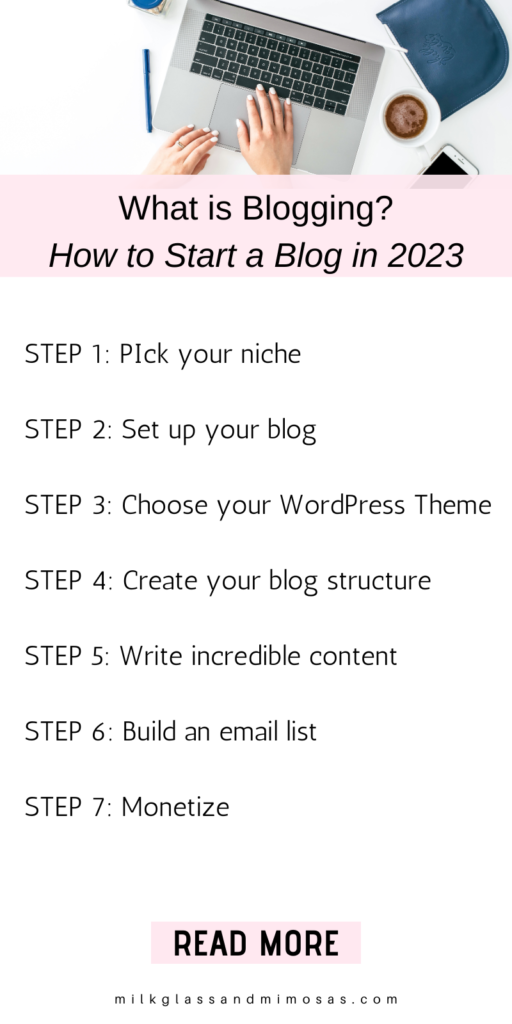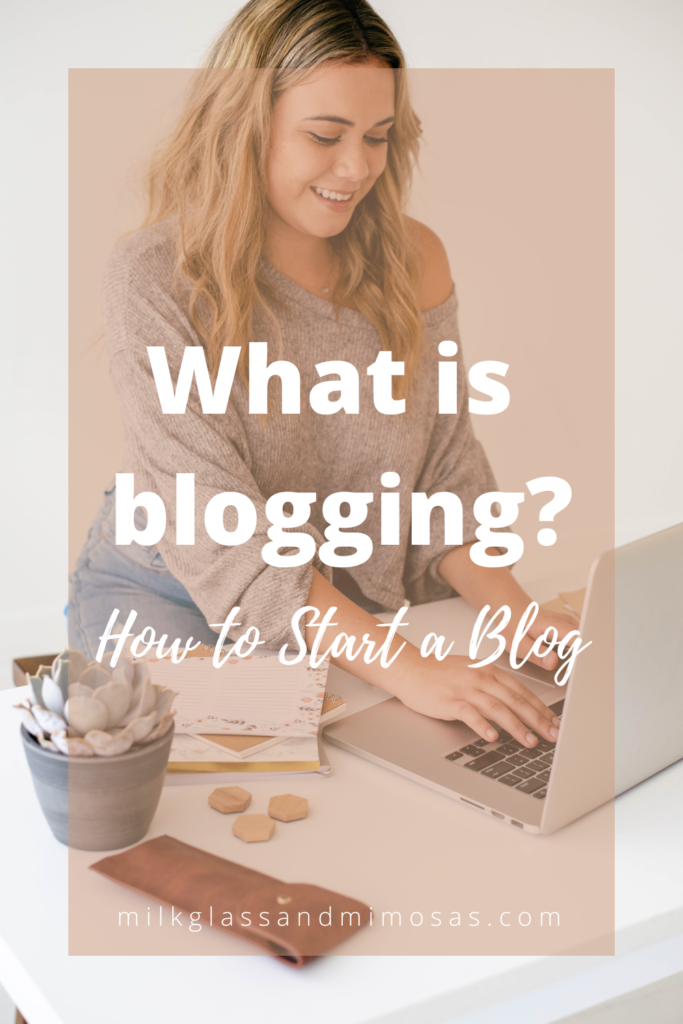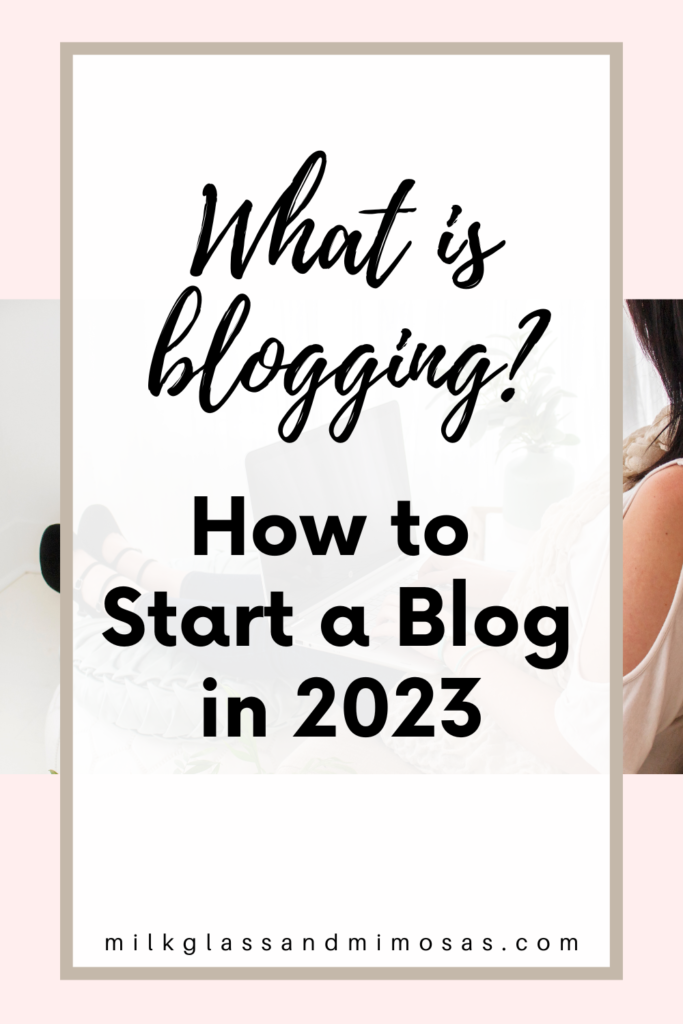What is blogging?
Blogging is an informational, often informal, website that provides frequent articles on a specific topic or related topics. A blog (shortened from the original “weblog”) can be run by an individual, group or corporation.

This post may contain affiliate links which means if you make a purchase, I receive a small commission at no additional cost to you. For more information, please read my disclosure policy.
How blogging works
Blogging involves creating a content calendar, writing and publishing blog posts, promoting blog posts and related products and fostering community engagement through comments. Email marketing and social media often accompany a blogging strategy.
A blog typically features a main topic, or niche, and targets a specific audience. In the blogging world, your target audience or ideal customer is often referred to as an avatar.
The blogger then creates content for their niche by doing keyword research. Essentially, this means writing content based on what their target audience is searching for online. A content calendar helps organize keyword topics and creates a schedule for publishing blog posts.
Following the content calendar, a blogger then writes and publishes posts and promotes those posts through channels such as Pinterest, social media and email marketing.
How to start a blog
Now that you know what blogging is, maybe it’s time for you to start a blog. That’s awesome! Starting a blog can be very rewarding and fun, especially if you like to write. It’s also a fun way to connect with others who are passionate about similar interests as you. Also, if you want to, it can be a way to make some extra income (more on that later).
Check out these steps to start your blog:
Step One: Pick Your Niche
The first step to starting a blog is to pick your niche. Simply put, a niche is the topic or focus of your blog. Think about what you’re passionate about or your area of expertise. Then ask yourself if this is a topic you could write about for a long time.
According to a study by RankIQ, the most profitable blogging niches (as of January 2022) were food, personal finance, mommy/lifestyle and travel. The blogging niches that had the most traffic were food, lifestyle/mom, travel and arts/crafts.
It’s important to remember that there are many, many blogs out there covering all niches. But that doesn’t mean there isn’t room for more. What’s important is putting your own spin on it and offering something that readers are searching for. For instance, if you want to cover travel, try to niche down even further to cover a specific demographic, like family travel with young kids.
Step Two: Set Up Your Blog
Setting up your blog means choosing a content management system (CMS), coming up with your domain name and purchasing a hosting service.
I personally use and recommend WordPress.org for CMS, as this will allow you to be self-hosted. This means that you will have full access to your site files. For hosting, I personally use bluehost, but there are many options available. Bluehost offers affordable hosting plans and a free domain name when you sign up. Plus, they make it very easy to set up your WordPress blog with just a few clicks.
Your domain name is simply your blog’s address on the internet (e.g., www. blogname .com).
There are a few things to keep in mind when choosing your domain name:
- Make it easy to spell and remember
- Keep it short
- Avoid using hyphens or numbers
- Choose a .com extension, if possible
Step Three: Choose a WordPress Theme
After you have registered your blog and installed WordPress, it’s time to choose a theme. A theme is the design of your website and controls how your content is displayed. There are both free and premium themes available which both have their own advantages.
Free themes are available through WordPress.org and obviously will save you money when you are first starting out. The downside of free themes are limited options in terms of layout and customization. Premium themes cost money, but offer a broader range of customization and tend to look more professional.
For this blog, I use the Isabelle theme from BluChic, but all of their themes are beautiful and feminine. Plus, they offer step-by-step tutorials, theme updates and email support in case you run into any issues.
Step Four: Create the Structure
Once your theme is set up, there will be certain elements that you can add to create structure.
Your theme will likely help you with the structure, but here are the basic elements that will help your readers easily navigate your site. Here are the top items you should have:
- Menu/categories – The main topics you cover in your niche.
- About Me page – Let readers know who you are and why you’re an expert in your niche.
- Contact page – Give a way for readers to get in touch.
- Legal Pages – To comply with federal and state laws, a blog needs to have specific legal pages including a Disclaimer, Terms & Conditions and Privacy Policy.
- Newsletter signup – See below for the importance of building an email list.
- Google Analytics – An important backend tool to track traffic. Check out this guide for adding Google Analytics.
Step Five: Write Incredible Content
The meat of your blog is your blog posts! You may have heard the phrase “content is king.” This is because high-quality, consistent content will help you rank higher in Google.
When writing your content, keep the following in mind:
- Write for your audience first and foremost – What information do they need? How can you help them?
- Keep your articles well-organized and easy to read – Use short paragraphs, headings, and bullet points.
- Use images, videos, and infographics – This will break up your text and make your articles more visually appealing.
Step Six: Build Your Email List
Growing an email list helps your audience is key to marketing your blog, which are keys to monetizing later. I recommend having homepage signup form, as well as lead magnet or freebie. This means offering something of value to your readers in exchange for their email address.
Consistent communication to your email list will help you grow your traffic and your revenue. Showing up with valuable content will keep your readers engaged and will eventually turn readers into buyers.

How to make money blogging
Following the steps above, your blog is already set up to monetize. Steady traffic and an engaged email list mean you are ready to start making money.
Bloggers can make money through various income streams. You can pick one or all, depending on your niche and marketing preferences. Here some of the top ways blogs monetize:
- Affiliate Marketing – Probably one of the most popular ways to make money is through affiliate marketing. This means promoting other businesses’ products or services and receiving a small commission for your referral. You can apply to individual affiliate programs for products you use and love or apply to affiliate networks which house multiple programs on one platform.
- Sell products or services: As an expert in your niche, you can create products or services to help your audience. Examples include printables, digital products, courses or providing 1:1 coaching.
- Display advertising: You’ve probably noticed that many websites have display ads. This is a popular option when you have steady traffic. Google AdSense is great for beginners but other companies also offer display advertising.
- Sell sponsored content: While not my favorite method, you can monetize your content by selling sponsored articles. A sponsored article is a blog post written to highlight a company or brand’s goods or services.
There are costs involved with running a blog, as you may have noticed from the set up stages. It’s perfectly acceptable to want to monetize, if only to cover the costs of maintaining your blog. It’s also okay to turn your blog into a business. If you offer products or services to your readers to offer a solution, you are helping them and they will be happy to purchase from you.
Once you start making money from your blog, you’ll want to track your income and expenses. Where is your money coming from? What are you spending money on? And if you are making money, you’ll also need to report your income for tax purposes.
Pros and cons of blogging
If you landed here because you were wondering ‘what is blogging’ and now you’re interested in starting a blog, you probably want to weigh the pros and cons. As with anything, there are some highs and lows that come with blogging.
Pro: You Can Make Extra Income
As noted above, there are ways to make money with blogging. This could mean just covering the costs of your hosting all the way to replacing (or exceeding!) your full-time income. The income potential is there if you put in the time and effort to build your blog as a business.
Pro: You Can Work from Anywhere
Since you only need a laptop and internet connection, you can basically work anywhere in the world. This means you can work from home or travel and still be able to maintain your blog and make money. If your goal is to replace your full-time income with your blog, this is an attractive feature, especially if you want to travel or stay at home with your family.
Pro: The Barrier to Entry is Low
Starting a blog requires minimum start up costs and requires little technical experience. While there is a learning curve to blogging systems and tools, many of the programs are easy to learn and do a lot of the technical work for you. Plus, there are a ton of free and low-cost resources available to learn anything you need about blogging.
Con: It Takes Time to Build Up Traffic
There are several ways to build traffic, but it can take time. Depending on how much time you are willing to invest in your blog, it could take months or even years to build a large enough audience to generate significant income. One of the biggest tips I can offer is to invest time in learning SEO or Search Engine Optimization. Ranking on Google and other search engines will help build traffic faster and more effectively if you do it from the beginning.
Con: It Can Be Competitive
According to statistics, there are more than 600 million blogs in existence today. That means there is quite a bit of competition out there to rank on search engines and grab readers attention. The good news is that there is room for everyone, if you have a unique perspective. Picking a niche and offering your personal expertise will help you stand out in the vast crowd of the internet.
Con: It Requires Consistent Work
If you want your blog to make money and be successful, it does take a lot of work. There is a myth out there that blogging is passive income. For sure, you can make money while you sleep and for years to come, but there is work that is involved in getting there. I’ve had my blog since 2016 and because I was not consistent, it took a long time to make money. The good news is, if you enjoy the topic you’re writing about and you like the marketing side of blogging, you will show up to do the work and you can be successful!

FAQ
What is a blog post?
A blog post is an article on a blog. Blog posts are individual pages on your blog that answer a specific question or topic related to your niche. Topics are typically discovered through keyword research, meaning that you are responding to a phrase frequently searched by your target audience.
Blogging vs. traditional websites
The main difference between a blog and a typical website is that a blog is updated frequently with new content and articles. A traditional website will stay the same for long periods of time. It is common for businesses with a traditional website to also have a blog for content marketing.
What is the purpose of a blog?
The purpose of a blog is to connect a target audience with updated information about a certain topic. Blogs are frequently used turn readers into customers through content marketing strategies. This is done because blog posts typically target specific search terms and provide free answers to common questions. The business can then connect the reader with products or services that further solve their problem.
Who is a blogger?
A blogger is a person who writes blog posts. You can write for your own blog, as an employee for a company blog or as a guest blogger for other websites.

Final Thoughts on “What is Blogging?”
Blogging is an amazing way to share your knowledge or passion with the world. Whether you’re looking to make extra money, replace your full-time job or just want to have an outlet for creativity, blogging offers something for everyone.
While it’s not a venture to overnight success, blogging can be very rewarding if you put in the time to consistently grow your audience and add in revenue streams. In addition to following the steps outlined above, there are a ton of resources here and on the web to continue to grow your blog.
Are you planning to start blogging or do you already have a blog? Introduce yourself and your niche in the comments below.
Really helpful and informative blog post for people who are thinking about starting a blog! I’m glad I started mine when I did (10 years ago!) I don’t think I could do it now!